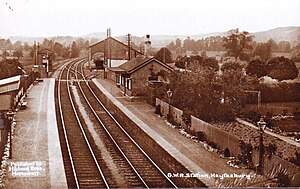| Heytesbury | |
|---|---|
 Heytesbury station c.1910 Heytesbury station c.1910 | |
| General information | |
| Location | Heytesbury, Wiltshire England |
| Coordinates | 51°10′35″N 2°06′41″W / 51.1764°N 2.1114°W / 51.1764; -2.1114 |
| Platforms | 2 |
| Other information | |
| Status | Disused |
| History | |
| Original company | Great Western Railway |
| Post-grouping | Great Western Railway |
| Key dates | |
| 30 June 1856 (1856-06-30) | Opened |
| 19 September 1955 (1955-09-19) | Closed |
Heytesbury railway station is a former railway station near Heytesbury, Wiltshire, England, in the Wylye Valley, about three miles south of Warminster.
The station serving Heytesbury opened on 30 June 1856, on the Salisbury branch line of the Great Western Railway next to the bridge carrying the minor road to Tytherington. Originally just a single track, the line was doubled eastwards in 1899 and then westwards to Warminster the following year. The original platform became the one used by trains towards Salisbury and a second was added with a small waiting shelter when the line was doubled, but there was never a footbridge between the two platforms. A goods shed stood on the north side of the line, to the east of the passenger facilities.
A 3.5 miles (5.6 km) branch line from the west end of the station was in use from about 1916 to 1926 to serve a military camp and hospital at Sutton Veny.
The station closed on 19 September 1955 but the signal box, which was opposite the goods shed, remained open until May 1968. The original station building is still standing but the rest of the station was demolished.
References
- Crittall, Elizabeth, ed. (1959). "Victoria County History: Wiltshire: Vol 4: Railways". British History Online. University of London. Retrieved 20 April 2020.
- Oakley, Mike (2004). Wiltshire Railway Stations. Wimbourne: The Dovecote Press. pp. 64–65. ISBN 1-904349-33-1.
| Preceding station | Historical railways | Following station | ||
|---|---|---|---|---|
| Warminster Line and station open |
Great Western Railway Salisbury branch line |
Codford Line open, station closed | ||
This article about a railway station in South West England is a stub. You can help Misplaced Pages by expanding it. |